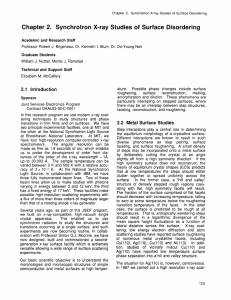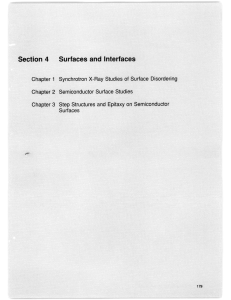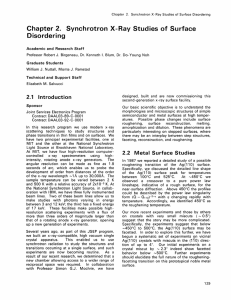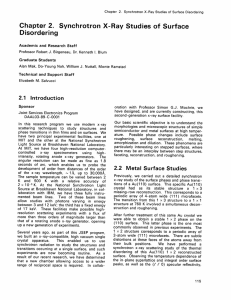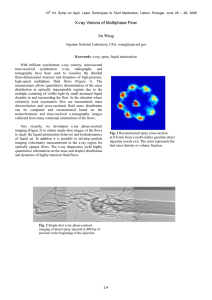Surfaces and Interfaces Section 4 1 Chapter 2
advertisement
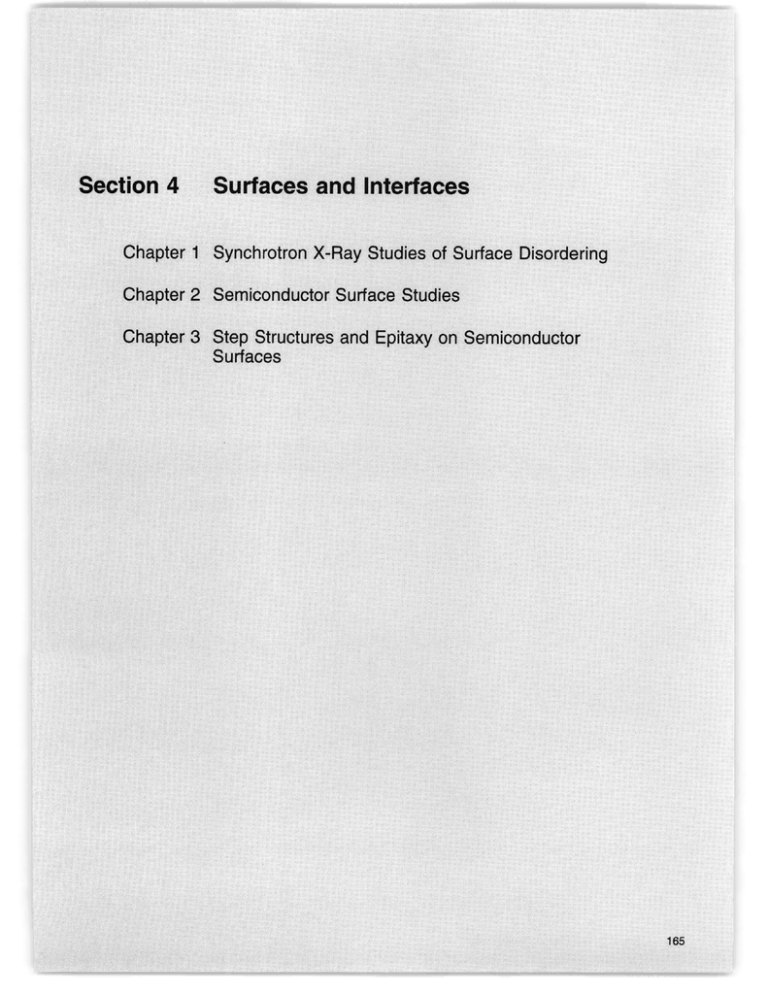
Section 4 Surfaces and Interfaces Chapter 1 Synchrotron X-Ray Studies of Surface Disordering Chapter 2 Semiconductor Surface Studies Chapter 3 Step Structures and Epitaxy on Semiconductor Surfaces 165 166 RLE Progress Report Number 139 Chapter 1. Synchrotron X-ray Studies of Surface Disordering Chapter 1. Synchrotron X-ray Studies of Surface Disordering Academic and Research Staff Professor Robert J. Birgeneau, Dr. Martin Greven Graduate Students Monte J. Ramstad, Michael J. Young Technical and Support Staff Debra L. Martin 1.1 Introduction Sponsor Joint Services Electronics Program Contract DAAL03-92-C-0001 In this research program, we use modern x-ray scattering techniques to study structures and phase transitions in thin films and on surfaces. We have two principal experimental facilities, one at MIT and the other at the National Synchrotron Light Source at Brookhaven National Laboratory. At MIT, we have four high-resolution computer-controlled x-ray The angular resolution can be spectrometers. made as fine as 1.8 seconds of arc, which enables us to probe the development of order from distances of the order of the x-ray wavelength 1 A, up to 30,000 A. The sample temperature can be varied between 2K and 500K with a relative accuracy of 2 x 10- 3 . At the National Synchrotron Light Source, in collaboration with IBM Corporation, we have three fully instrumented beam lines. Two of these beam lines allow us to make studies with photons varying in energy between 3 and 12 keV; the third has a fixed energy of 17 keV. We are currently commissioning an undulator-based beam line at the Advanced Photon Source at Argonne This facility will make posNational Laboratory. sible a new generation of x-ray experiments with unprecedented precision. In collaboration with Professor Simon G.J. Mochrie, we have designed, built, and commissioned a second-generation x-ray surface facility which is extremely versatile allowing a wide range of surface scattering experiments. Our basic scientific objective is to understand the morphologies and microscopic structures of simple semiconductor and metal surfaces at high temperatures. Possible phase changes include surface roughening, surface reconstruction, melting, amorphization, and dilution. Semiconductor surfaces exhibit rich structural and morphological behavior in both equilibrium and nonequilibrium, steady state conditions. Equilibrium structures and phase transitions of high-symmetry facets are often closely related to important models in two-dimensional statistical mechanics. The physics of stepped (vicinal) surfaces, even in equiFor librium is subtle and poorly understood. example, stepped surfaces should always be rough because of the freedom of the steps to wander. Steps structures and spacing should be profoundly affected by any nearby high-symmetry surface reconstruction. Their association bears on issues of faceting and equilibrium crystal shapes. The steps themselves may exhibit phase transitions that involve dislocations and/or bunching in the step lattice as well as step-height changes; changes in the morphology, especially those involving vacancy aggregates, should be strongly affected by nearby steps. Semiconductor surface physics involves fundamental issues in statistical mechanics that are important to a broad spectrum of other problems. Furthermore, elucidating the factors that control the morphology and perfection of vicinal semiconductor surfaces can be expected to lead to improved electronic device processing and ultimately improve semiconductor device performance and lifetime. 1.2 Stability of Vicinal Si(111) Surfaces Under Sublimation and Electromigration We have carried out an extensive investigation of the properties of miscut Si(111) surfaces under the application of applied electric fields. Specifically, we have studied electromigration-induced morphology changes occuring at the surface of vicinally polished, clean single crystals of Si(111). From these studies, we have determined the nonequilibrium phase diagram and structures. Chapter 1. Synchrotron X-ray Studies of Surface Disordering T(K) 1520K 1370K Stepped surface (single-phase region) Foceted surface (with transverse instability) T7x7-1 xl --------------- -I 140K 7x7 Reconstruction 7 x7 Reconstruction I 7x7 Reconstruction (with transverse instability) ,Current Direction Figure 1. Current-direction versus temperature phase diagram for vicinal Si(111) miscut toward <112> indicating some of the regimes where electromigration-driven surface morphologies exist, and the region where reconstruction-driven step bunching is observed. The dashed line indicates the T7X7 - 1x1 reconstruction temperature which is weakly dependent on the magnitude of the miscut. Bars indicate regions studies with x-ray diffraction. A current direction versus temperature phase diagram for Si( 11) vicinally cut toward <112> is shown in figure 1. These surface phases can be described as follows. Below the 7X7-1X1 reconstruction transition, one observes a surface phase separation independent of current direction. This two-phase region consists of large 7X7 terraces separated by step bands. The flat terraces have a surface normal (n) along (111) while the bunched step regions have a local surface normal which is larger than the macroscopic miscut. In equilibrium, the relative size of the flat regions compared with the step regions is then determined by the 168 RLE Progress Report Number 139 macroscopic miscut. This is illustrated in the schematic of figure 2. In this diagram, positive current (+1) is defined as current flowing toward <112>, i.e. in the direction of the step flow. The positive current direction is sometimes referred to as the step-down direction. The crystallographic direction transverse to the miscut is the <110> direction. It was found experimentally that the phase separation at positive current is accompanied by a transverse instability due to a meandering of the steps within the step bands. The small dependence of reconstruction transition temperature on sample miscut is not represented in this phase diagram. Chapter 1. Synchrotron X-ray Studies of Surface Disordering (a) +1 Uniformly Stepped <111> n n (b) <112> Step Bunching (Faceting) I Figure 2. A schematic of (a) a uniformly stepped surface, and (b) a step bunched (or faceted) surface. Positive current flows in the step-down <112> direction, as indicated by the arrow in (a). A uniformly stepped Si(111) surface will have steps distributed according to the macroscopic miscut (defined by n) and separated by 1X1 terraces. The angle & will be a function of the step density within the bunched regions (step bands). Above the reconstruction transition temperature at T-1140 K and at negative current (-I in the diagram) there is a transition to a single-phase uniformly stepped region which persists up to T-1370 K. This single-phase surface has steps separated by disordered 1xl terraces, typically a few hundred angstroms across. Therefore, the integer order peak at (1,0) are not present when scattering x-rays from the single-phase stepped surface structure. At positive current between these same temperatures, the steady-state surface structure consists of unreconstructed 1X1 facets, which also with a transverse step meandering. The phase behavior on reversing the current direction in this temperature regime is driven by electromigration. It should be noted that these low-temperature phases exhibit very slow dynamics and were not part of the major thrust of this research. Above T-1370 K and at negative current, the steps tend to bunch into disordered stepped bands, allowing the slow formation of large 1xl facets. At this same temperature and positive current, these steps bunches slowly reorganize as the facets decrease in extent. The eventual surface structure consists predominately of distributed steps with a 169 Chapter 1. Synchrotron X-ray Studies of Surface Disordering large transverse step meandering. The transverse step modes ultimately lead to a dramatic transverse modulation on the order of several microns depending on the size of the miscut. Heating through this faceted regime at negative current one encounters a transition at T-1525 K. In this case, the steps redistribute themselves uniformly with no significant transverse wandering. At positive current above T-1525 K, the surface develops facets with disordered step bands, although the excessive sublimation rates at these temperatures prohibit well-ordered facets after a long time. This electromigration- or current-driven faceting shares many of the same characteristics with reconstruction-driven faceting; however, it is obviously governed by fundamentally different physics which can lead to dramatic dynamical changes. After completion of the above work, further ultrahigh vacuum (UHV) surface x-ray diffraction experiments were conducted to study the time-dependences of the effects of a direct current on the arrangement of the steps at a Si( 11) crystal surface miscut toward <112> by up to 8 degrees. These studies revealed spectacular dynamical changes in the surface morphology which are reversible and can be controlled by the direction of current flow through the crystal. The current direction- and time-dependent morphology changes in question were found to result from an intricate set 170 RLE Progress Report Number 139 of competing interactions, electromigration being a central component and actually occur at sublimating temperatures. Moreover, the time-scales involved in many of these surface transformations proved to be readily accessible in the x-ray diffraction experiments. The surface morphology changes which characterize this dynamical phenomenon occur on mesoscopic length-scales and exhibit time dependences which are ascertained directly from the surface diffraction experiments. Ex-situ atomic force microscopy experiments were also conducted on quenched samples following each experiment to complement the x-ray studies. Direct imaging proved useful in determining large-scale structure which in some cases occurred at distance scales exceeding the resolution of the x-ray experiments. 1.2.1 Theses Ramstad, M.J. Instabilities of Vicinal Silicon (111) Surfaces. Ph.D. diss., Dept. of Physics, MIT, 1996. Young, M.J. Equilibrium and Non-Equilibrium Phenomena in Two- and Three-Dimensional Correlated Systems. Ph.D. diss., Dept. of Physics, MIT, 1996.
